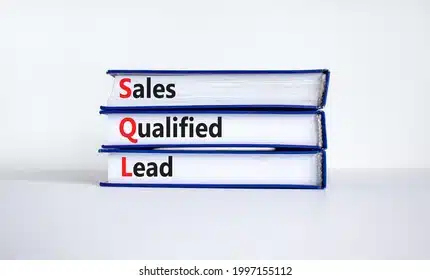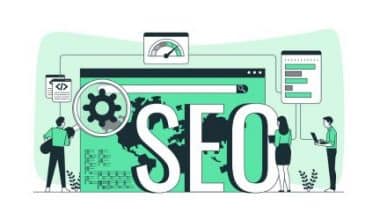Sales managers who are on top of their game know better than to send their employees after cold leads. They invest their meager funds in leads they have a thorough grasp of and those they believe have the best possibility of becoming paying customers. In other words, sales managers do not hand out unqualified leads to their sales teams. Salespeople may assume all opportunities are worth their time. However, time is money. So this isn’t always true. While you can market to almost anyone, you don’t want to market to those who won’t convert. Your bottom line will suffer from squandered expenditures and low conversion. This is where Sales Qualified Lead comes in. These leads can be employed in your lead conversion process, which should focus on nurturing to convert them. In this article, we will discuss the sales-qualified lead opportunity and the difference between marketing-qualified leads.
What is a Sales-Qualified Lead?
A sales-qualified lead (SQL) is a potential customer that has been thoroughly investigated and validated by both the marketing and sales departments of a firm. A qualified sales lead (SQL) is a potential customer who has shown interest in purchasing a company’s goods and services and who also meets the company’s lead qualification requirements. Also, a qualified lead is a prospect who has moved passed engagement and can be actively pursued to become a paying customer.
Furthermore, marketing and sales departments frequently disagree on what constitutes a sales-qualified lead, even within the same company. When a business is trying to generate interest in its products, it frequently begins by identifying marketing-qualified leads (MQLs). Once a marketing-qualified lead demonstrates a readiness to purchase, they are transferred to the sales team and considered as SQL.
The company’s lead management method uses the prospect’s behavior to establish whether or not they are a qualified SQL. However, lead scoring is used by companies to zero in on serious buyers in an effort to save salespeople time and speed up quota achievement. In a perfect world, the sales and marketing departments would work together to establish the criteria that must be met by a prospect before moving on to the next phase. When marketing passes along leads to sales that aren’t serious about making a purchase, it slows down the sales process and is a common source of problems related to lead quality.
How Do You Get Sales-Qualified Leads?
A company’s bottom line can’t survive without a steady stream of sales leads. However, the “business machine” only functions when there is a steady flow of sales-qualified leads to be converted into customers. This is more important than a well-coordinated marketing and sales plan.
It’s not enough to only generate leads. It’s crucial that these new connections “affinity” with the service or product being offered. Without first qualifying new leads, businesses waste a lot more time and money trying to convince prospects to buy. Now you know why it’s crucial for your business to have a steady stream of sales-qualified leads. Here is how to get sales-qualified leads.
#1. Use Long-Tail Keywords
Spend some time researching long-tail keywords before developing search engine ads, website content, or landing page copy. A set of terms that is highly relevant to a company and has higher “search intent” The catch is that long-tail keywords tend to have less traffic, but the people that search for them are more likely to be interested in what you have to offer.
utilize alternative phrases like “what is the solution,” “how to use solution,” and “solution benefits” in place of “solution” when generating fresh content to illustrate the concept. If you want to improve your search engine rankings, it’s also a good idea to include synonyms in these variants. To discover fresh keyword prospects, we recommend using Google Trends and the Keyword Planner.
In advertisements, the CPC or CPL is typically cheaper, but the “search intent” is much higher than the general term — in our case, “solution” — which is why it generates sales-qualified leads. Long-tail keywords have less competition and traffic in organic rankings, but content tailored to each individual term has a higher chance of being read, clicked on, and converted.
#2. Proper Social Media Campaigns
Building rapport with potential clients through social media is an excellent strategy. However, companies with complex sales processes should put their money into customer acquisition and retention strategies. This can be accomplished through engagement initiatives that aim to spark conversation about your product or through traffic campaigns that direct potential customers to relevant content.
The reason it helps produce sales-ready leads is that it allows you to segment your most important followers and send them very specific offers based on their previous engagement with your content. Never expect to receive anything in social media without first providing something of worth. That’s why it’s important to plan separate ads for each phase of the buyer’s journey if you want to build a loyal following.
#3. Landing Pages With End-Of-The-Funnel Material
Building landing pages is a great way to funnel visitors into your organization. However, there are other ways to make use of them besides only selling ebooks and infographics. Our advice for attracting a sales-qualified lead is to provide content toward the bottom of the sales funnel, targeting prospects who are already thinking about buying a product or service like yours. Examples include case studies, customized advice, product presentations, in-depth seminars, and test drives of online applications.
Progressive profiling forms are a useful tool for increasing the efficiency of your landing page approach by prompting leads who have already filled out a form on your website to provide additional information. That is to say, they won’t have to repeat themselves and every piece of content they acquire will add to their profiles and strengthen their cases for acceptance.
The reason it creates sales-qualified leads is that: Bottom-of-the-funnel content attracts leads who are actively looking for a solution to their problem, as well as businesses that are a good fit for your product or service. With progressive profiling landing pages, you can gradually qualify leads by gathering more and more information about them. This information is useful for marketing and sales teams in determining which leads are most prepared to be approached.
#4. Develop Informative and Technical Content
One strategy to attract leads who already have the technical expertise to make full use of your product or service is to provide them with access to solution-specific content. information centered on features, implementation, and technical details is what I have in mind, not “what is it” information.
If you own software as a service business, you should consider using content marketing to get the word out about your new offerings. If you’re proposing an innovative solution, explain how it will improve things and why it’s worth doing. Also, paid ad campaigns are fantastic for spreading awareness of this material and drawing in prospective customers.
The reason it brings in a qualified sales lead is that prospects are more likely to see value in what you’re selling when they can speak with people who have firsthand experience with the solution. That’s because demos show them exactly how it can improve their company. In addition, to expand your pool of potential customers, you can combine this tactic with social media advertising.
#5. Intentional Networking for Job Hunting
Once you have access to relevant data about a company’s industry, market, and personnel count, professional networks can be a gold mine for a qualified sales lead. Professionals, startup entrepreneurs, and decision-makers can network and locate potential business partners using sites like LinkedIn, AngelList, and F6S.
Our advice is to use these business networks to do targeted searches based on criteria such as a contact’s field, geography, or even the size of their company. It will aid in the pursuit of sales leads that are a good fit for your company. The value of your solution is more likely to be acknowledged by influencers, decision-makers, and even CEOs if you reach out to them.
Because it facilitates communication with decision-makers in charge of purchasing and implementing a solution by means of segmented contact research in corporate networks, it generates sales-qualified leads. Tools like Skrapp and Hunter can be used to increase your lead generation efforts.
#6. Marketing Alliances and Joint Ventures
Partnerships with companies operating in the same market as your own are prevalent in business, especially in the realms of technology and software as a service. It’s a tactic whereby multiple businesses work together to create content or host an event for an audience that could use the services they provide.
For instance, two businesses operating in the B2B technology sector might join forces to host a full-length webinar devoted to the most effective methods for streamlining content marketing processes. Each business used its own social media channels to spread the news, opening up new markets, prospects, and chances for the other.
Co-branding marketing initiatives are effective at generating sales-ready leads since it is as if both organizations “share” their contact lists with each other through the use of newsletters and targeted emails. If a partner provides a contact list from which new leads can join, it is likely that these leads have already passed the other company’s qualification processes. In other words, sales-qualified opportunity improves when leads have more information.
#7. Participate in or Host Exhibitions, Fairs, and Conferences
In this case, the sales team was actively prospecting for leads. It is beneficial for a company’s market presence and positioning to participate in or sponsor corporate/business events and conferences. In addition, networking can be a terrific way to meet potential customers who are experiencing problems that can be alleviated by your product or service.
That’s because people who attend corporate events are more likely to learn about tools and strategies that can help them streamline operations and expand their customer base. Find out if there are any enjoyable activities in your area, given that information. If not, then organize your own gathering. Even if you only get a few dozen people to show up at first, you’ll be able to grow your brand and make some excellent connections.
Furthermore, a sales-qualified lead is created since corporate events are known for attracting the attention of influential and decision-making individuals. Some sponsorship levels provide you to reach a targeted audience and showcase your product. With this information in hand, you may entice them to check out your website and learn more about your business.
Sales Qualified Lead Vs Marketing Qualified Leads
The intention to purchase is what distinguishes a Sales-qualified lead from a marketing-qualified lead. An SQL is a potential customer that is eager to speak with a sales representative and has already made up their mind to buy.
This distinction is critical because it determines the next step in the lead nurturing process depending on the customer’s stage of interest. Never give a lead information that has nothing to do with their buying process. In addition, MQLs are not yet ready to buy, so sending them to your sales team too soon can turn them off to your product and waste the sales rep’s time.
You wouldn’t want to send a first-time visitor who downloaded some research-based informational content to your sales team, for instance. Content such as “Best CRMs of 2023” could be used to promote customer relationship management software. Also, they qualify as a marketing-qualified lead because they just started the buying process.
However, if they are a returning visitor who downloads content corresponding to a specific activity or bottom-of-funnel content like “Things to Know Before Purchasing CRM Software,” then this is a prime candidate for a sales-qualified lead. They’ve moved past the discovery phase and shown through their online actions that they’re prepared to take the next step.
The Importance of Knowing the Difference Between a Sales and Marketing Qualified to Lead
The system can save your salespeople time, allowing them to spend more time selling to the right individuals at the right time, thus it’s crucial for them to understand marketing and sales-qualified lead.
In an ideal scenario, your sales team would have access to more qualified lead thanks to lead scoring and the subsequent conversion of marketing to sales-qualified leads.
In addition, by keeping tabs on marketing-qualified leads and a sales-qualified lead, your sales and marketing teams can learn what’s bringing in leads and how likely they are to become closed deals. Also, how often does your sales team succeed in closing SQLs? Is there an increase in the quality of discourse among your sales staff?
What Are the Steps Involved in Transforming a Marketing Qualified Leads Into a Sales Qualified Lead?
Take into account the following steps when transforming marketing and sales qualified leads.
#1. Lead Score
Lead scoring is typically the first step in a company’s process for converting a lead into a qualified sales lead (SQL).
Researchers define lead scoring as “the practice of evaluating the quality of inbound marketing leads by assigning each one a score,” typically a numeric value.
However, you can assign a lead score depending on a number of factors, such as the quality of the information they provided you with and how they interacted with your website and brand elsewhere online. By following this procedure, sales and marketing teams are better able to prioritize leads, provide timely responses, and ultimately convert a higher percentage of those leads into paying customers.
Also, lead scoring helps sales teams prioritize contacting just those prospects who have expressed interest in learning more about your company and its offerings.
#2. Lead Behavior
The sales and marketing departments coordinate to establish the criteria that a prospect must meet before moving on to the next stage of the sales process. You will define the qualities of a good leader and establish the significance of certain behaviors.
These steps could include things like scheduling a meeting, taking part in a demo, or replying to an email. Then, scheduling a meeting could be worth more points than replying to an email.
Your marketing team may try to close deals with prospects who aren’t ready to move on in the sales process if they don’t have a clear path to do so. On the other hand, your sales force as a whole will slow down.
So, what actions can move a prospect forward? Interaction with your website is one possible method of this. Say a potential customer shows interest in your business by visiting your website, reading your emails, and downloading your lead magnets. They are obviously considering what you have to say. Based on their interaction with you, they may be ready to move from marketing to sales-qualified lead.
Also, negative activities could be included as well. If a lead stops responding to your messages or stops checking your emails, for example, their score will decrease.
#3. Purchasing Probability
Customers that are qualified to become SQLs have demonstrated a need for your product or service, have the financial resources to buy it and the necessary IT infrastructure in place to make effective use of it, and have problems that can be alleviated by using your product.
The BANT system (Budget, Authority, Needs, and Timeline) was put together with this goal in mind. Although this method shouldn’t be used to ask a set of questions, it can help you determine whether or not you’re dealing with a potential consumer who is a suitable fit. You should still list essential actors, identify your target customer’s challenges, and learn about their company’s processes.
#4. Leads as Part of Your Sales Flow
Improve your sales procedure so that you can make the most out of every marketing-generated lead.
Salespeople need to get ready for conversations with a sales-qualified lead just like they would with any other leads, but they can also leverage data acquired via marketing-qualified lead nurturing to help them seal the transaction. You should know how a prospect’s SQL files got to be SQL and what kinds of files they download.
The next step is to talk to them and understand their circumstances so you can better sell them your products.
Sales Qualified Opportunity
Discovery calls are among the most crucial interactions between salespeople and prospective clients.
The next step is either to continue talking to the prospect and go forward or to say goodbye.. But it’s not always easy to make that call. In this case, sales qualification is useful.
If a contract looks promising, asking the right questions will help you decide if the partnership is worth keeping.
What Is Sales Qualified Opportunity?
A “Sales Qualified Opportunity” (SQO) is a term used to describe a potential sale that meets certain criteria. The salesperson fills it out to detail how they’ve used your offerings to qualify leads. The salesperson will reject them outside of Salesforce or your CRM system if they are not a suitable fit.
As a qualifying metric, a sales-qualified opportunity is one of the key reasons for its significance. As a result, salesmen can more precisely define their target demographic. These requirements are significant because they inform the salesperson’s relationship with prospective clients.
If they decide to turn down a customer, they are allowed to elaborate on their decision to their sales manager. With this information, the sales manager will be better able to connect with and motivate the employee.
Also, a sales-qualified opportunity is useful for expanding businesses because they help them anticipate the wants and needs of new customers. The business can then figure out how to improve the client’s experience.
Furthermore, SQOs promote expansion because they enable organizations to report on customers’ experiences. Businesses can gain useful insight from customer complaints in order to improve their offerings.
Why Is Sales-Qualified Opportunity Important?
For businesses that depend on the success of their sales teams to increase profits, tracking a sales-qualified opportunity is important. Keeping tabs on your sales-qualified opportunity can reveal which promotional strategies yielded the best results for your business.
Set up a company profile on LinkedIn if most of your SQOs come from there to promote your brand.
Also, you may learn more about the quality of your leads by keeping tabs on a sales-qualified opportunity. If you don’t track certain leads, your firm could lose a lot of money.
SQOs are also useful for determining where to find the most promising new customers. These leads can be analyzed to see which strategies are working best, and then those strategies can be refined.
Keeping tabs on your sales-qualified opportunity can also reveal which advertising channels are bringing in the most business. For instance, if you discover that the vast majority of your leads originate via email marketing, you can tailor your efforts to better serve this channel.
What Is the Difference Between a Sales-Qualified Opportunity and a Lead?
A lead is a potential customer who has never done business with you before but shows interest. Using the information at hand, decide whether or not they are competent, and then reject them if they are not. In this method, you won’t waste time on unqualified leads.
A sales-qualified opportunity is a lead that shows promise, is interested in what you have to offer, and is a good fit for your company. They qualify as a potential client and should be entered into your CRM or sales pipeline as such.
Also, this will help you zero in on the customers who are the best fit for your company. If they aren’t a good fit, you can turn them down and go on to the next lead. In this method, you won’t waste time on unqualified leads.
What Are the Benefits of a Sales-Qualified Lead?
Here are the top 3 benefits of a sales-qualified lead.
#1. Insight About Potential Customers Improves
In business, trust is crucial. When people get to know and trust you, selling becomes simpler and less of a struggle. Forrester found that nurturing leads and building trust can generate 50% more sales opportunities at 33% lower expenses. Buyers can get additional information about leads by asking questions, and sellers can help them out by answering those questions. Qualifying leads begins with gaining in-depth familiarity with them. Understanding your target market and how well your product or service will appeal to them begins with this. People, not statistics, are your ultimate target market. Customers are more likely to make a purchase from a vendor who shows an interest in meeting their specific requirements.
#2. Saves You Both Time and Money
For every business with ambitious goals, time is of the essence, yet many sales teams waste it on low-quality leads. Salesforce found that salespeople spend 33% of their time on sales and the rest on non-value-added chores. Having a lead qualification process in place can help sales teams focus on the most promising leads.
Furthermore, once a lead has been qualified, sales representatives can prioritize their time and energy accordingly. Scoring qualifying prospects is possible once you input the aforementioned variables. A higher lead score indicates that you should prioritize responding to this lead over others.
#3. Increases the Quality of Your Sales Connections
Organizations that invest time and effort into learning about their clientele are more likely to develop strong relationships with them, which in turn leads to increased sales and profits. If you want to consistently boost sales, your organization should enhance its relationships with prospects and consumers. Salesforce reports that 76% of customers have high expectations that businesses would meet their requirements.
In what ways do qualifying leads aid in establishing rapport with prospects? Context is fundamental to the lead qualification process. Give some context about your audience, their problems, and how they came to consider you as a solution. Conversations can be enhanced with this background information. However, a salesman who knows more about their customers has more to discuss with them and can provide greater value.
Furthermore, you’ll gain your prospects’ trust and more chances to talk to them if you show that you understand and care about the problems they’re facing. When you know your customers inside and out, it’s far easier to strike up meaningful discussions with them, guide them through each step of the buying process, and earn their trust along the way.
Conclusion
Using the BANT architecture, you can pinpoint the most promising leads, customize the user experience for each one, and ultimately increase conversions and revenue.
Keep in mind that not all leads are the same, and work with your sales and marketing teams to craft the right messages and convert leads that are ready to go ahead in the sales funnel.
FAQs
Is a Qualified Lead a Prospect?
People who express interest in purchasing from you are called leads. They are familiar with your brand and offerings, but they have not been qualified, thus it is unclear how likely they are to make a purchase from you. Instead, prospects are leads that have been screened and are considered a good fit for your business.
What are MQL and SQL?
A marketing qualified lead (MQL) is a potential customer who has expressed interest in your company’s services. Those who are interested and likely to make a purchase are known as sales-qualified leads (SQLs). Because of this distinction in intent, MQLs, and SQLs necessitate distinctive forms of advertising, outreach, and other brand messages.
What Happens After Sales Qualified Lead?
Marketing-qualified leads will be fostered further until they are sales-ready, while sales-qualified leads will advance to the next level. A qualified lead is one that can be converted into a sale by passing it on to the sales department.
Similar Articles
- Beyond Cold Calling: Effective Techniques for Lead Generation
- LEAD MANAGEMENT SYSTEM: Definition and How It Works
- LEAD MANAGEMENT: Guide And Best Practices
- BUSINESS LEADS: Meaning, Examples of Business Leads Websites & Providers
- SEARCH ENGINE MARKETING SERVICES: Top Best (SEM) Agencies of 2023






